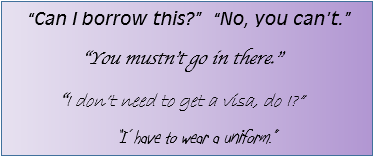This post is about modals for permission and obligation. Modals for prediction or requests, or for other things are in other posts.
1. Permission
Can, could and may are commonly used to talk about permission.
a. Can
Can is usually used to ask for and give permission.
Can I borrow your pen? > Yes, you can.
You can take one.
Can I ask you something? > Of course you can.
b. Could
Could is used to ask for permission. Could is more formal and polite than can. We do not give permission with could.
Could I borrow your pen? > Yes, you could can.
Could I have another cup of tea, please?
c. May
May is more formal. You can ask for and give permission with may.
May I see your passport, please? > Yes, you may.
You may keep it.
This lecture may be recorded, if you wish.
Other ways to ask permission include: Do/would you mind if I …? , Is it OK if I …? , Would it be OK if I …? , Is it possible for me to …? , Do I have permission to …? , Is it permissible to …? , and so on.
2. Prohibition
Can’t and mustn’t can be used to show that something is not allowed, or cannot be done.
a. Can’t
Can’t is used to talk about something that is against the rules. The rules are often made by companies or other people.
We can’t take photos in the theatre.
You can’t buy alcohol. You are too young.
Sorry, you can’t smoke here.
b. Must not/Mustn’t
Must not is used to talk about things that are not permitted. It is very common in writing, for example, on signs or notices.
Hotel guests must not smoke in their rooms. Please use the designated smoking areas outside the hotel.
Bags must not be left unattended.
Passengers must not speak to the driver while the bus is in motion.
Mustn’t is commonly used when the speaker makes the rule about what is not permitted.
(Friend to friend) Hey, you mustn’t go in there! You’ll get in trouble!
(Parent to child) You mustn’t hit your little brother!
I mustn’t forget to buy eggs.
Other ways to show prohibition include: You aren’t allowed to … , It’s/You’re not permitted to … , Don’t … , … is prohibited, and so on.
3. Obligation
Have to and must are commonly used to show obligation.
a. Have to
Have to is commonly used for external obligation – something that someone else tells us we have to do.
He has to bow when a customer enters or leaves the shop.
Why do I have to do it? Why can’t my brother do it?
I have to work next Saturday. I’m really annoyed.
b. Must
Must is used for strong obligation or necessity. It is often used for personal obligation (something the speaker thinks they need to do) or in written notices or signs.
I must remember to buy a birthday present for my sister.
You really must study harder, you know. You want to get good grades, right?
(In a museum) Any large bags must be checked at the cloakroom before entering the museum.
Other ways to show obligation include: You are expected to … , You are obliged to … , among others.
4. No obligation
Don’t have to and don’t need to are commonly used to show a lack of obligation.
a. Don’t have to
Don’t have to is used to show there is no obligation. It is optional and your choice. If you want to do it, you can.
You don’t have to come to the party if you don’t want to.
We don’t have to go shopping today. We have enough food.
You don’t have to help me. I can do it. > No, I want to help.
b. Don’t need to
Don’t need to is also used to show that there is no obligation. It often suggests that there is no purpose or reason to do it. It is also optional.
You don’t need to help me because I’ve almost finished.
You don’t need to get a visa to visit England because you are only going for 2 weeks.
You don’t need to cook it. It has already been cooked.
Other ways to show a lack of obligation include: It’s up to you. , There’s no need to … , You aren’t obliged to … , you can choose whether to … or not, among others.
ラボール英会話教室.png)
